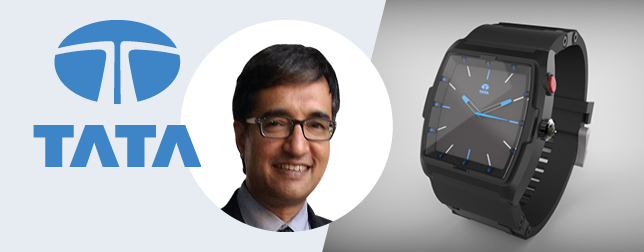Tata Elxsi is amongst the world’s leading providers of design and technology services for product engineering and solutions across industries including Broadcast, Communications and Automotive.
It provides technology consulting, new product design, development, and testing services. Tata Elxsi also provides solutions and services for emerging technologies such as IoT (Internet of Things), Big Data Analytics, Cloud, Mobility, Virtual Reality and Artificial Intelligence.
We interviewed Nitin Pai, Senior Vice President of Marketing and Strategy to tell us more about the Tata watch and design thinking for industrial and professional wearables.
Tata Elxsi is working with customers across the world, helping them design and deliver great experiences through their products and services. What is the strategy behind your services?
Technologies such as IoT, AI, virtual and augmented reality, are enabling completely new products, services and interactions, in ways never seen before.
While these technologies bear great promise, they also generate enormous complexity both in the creation and use of these new products and services.
Consumers are demanding simple and meaningful experiences in the use of product and services, transcending underlying technologies and going beyond features and functionality.
Tata Elxsi’s consumer insights and design thinking experience that has been honed over two decades of working with leading global brands across industries, coupled with deep technology expertise and specialist digital capabilities, allow us to harmonize not just form and function, but also the physical and digital aspects, creating new and great experiences for end users.
Our integrated Design and Technology teams help enterprises reimagine their products and services – from strategy, consumer research and insights, to service and experience design, technology implementation, integration, launch and beyond, to help create great consumer experiences and exceptional outcomes for the brand and business.
Beyond the crowded consumer-fitness segment Tata developed a safety wearable watch for the workers of Tata Steel to reduce shop floor injuries. As Tata Elxsi is part of this project can you tell what makes this product stand out in the market talking about a unique selling point?
It is differentiated in its sensor capabilities which have been integrated to suit the particular needs of the workers in that industry, as well as a version that uses LoRa technology (Low Power Wide Area Network) to better address aspects of battery consumption, range, coverage area and infrastructure cost through the network of Tata Communications. Apart from monitoring the wearer’s health parameters as well as his/ her location, the watch also checks for presence of specific noxious gases in the environment and the ambient temperature, both of which have significant safety implications for workers.
What are main challenges of design thinking for industrial and professional wearables?
The key challenge is to be able to relate fully to the purpose that the wearable is required to serve, the operating environment and the context of the wearer. Just to list a few aspects, the design teams need to consider
- key parameters that really matter in the context of that particular industry and operating conditions – this impacts everything right from what kind of sensors, connectivity protocols, and casing, to selection of components for operating temperature, etc.
- the nature of work and workwear of the worker – this drives how and where the device should be worn to ensure effective performance. For example, workers wearing gloves cannot access or easily check typical wrist-worn devices; audio alarms may be muffled or not heard at all in noisy conditions, etc.
- social aspects of ensuring the wearable is always worn while required, and addressing concerns of intrusion of personal space and information of the wearer. In the case of industrial or professional wearables, the information is often consumed not just by the wearer but also the supervisor/ management – this is often overlooked in design, and makes a crucial difference in acceptance and adoption
Do you have any more projects planned in the field of industrial and professional wearables?
We are working on a variety of projects – for companies who are developing wearables for specific industrial scenarios, as well as companies who have developed unique sensor technologies and want to build Systems-on-Module (SoM), develop SDKs and make these available for wearable development. Also, some interesting developments around augmented reality and related wearables for industrial applications.
Completely separately, we are currently engaged in wearables for medical and therapeutic applications which can provide continuous monitoring of health conditions and in certain cases, drug delivery too.
What is your favorite wearable device (except your own) at the moment?
1. The Dash Pro from Bragi, for its simplicity, form factor and ease-of-use. Of course, we have large debates on whether an earbud should be classified as a wearable.
2. The HoloLens which we used to create a unique mixed reality experience for the launch of a new sports car for Tata Motors at the Geneva Motor Show 2017, is intriguing in the possibilities it represents for mixed reality and what will happen in this space. This has great significance for industrial/ professional applications too.
If you want to learn more about Tata Elxsi and design thinking for industrial and professional wearables, Mr. Pai will be speaking at the WT | Wearable Technologies Conference San Francisco July 25-26.












